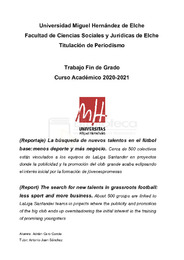Please use this identifier to cite or link to this item:
https://hdl.handle.net/11000/26544Full metadata record
| DC Field | Value | Language |
|---|---|---|
| dc.contributor.advisor | Juan Sánchez, Antonio | - |
| dc.contributor.author | Caro García, Adrián | - |
| dc.contributor.other | Departamentos de la UMH::Ciencias Sociales y Humanas | es_ES |
| dc.date.accessioned | 2022-04-07T09:22:59Z | - |
| dc.date.available | 2022-04-07T09:22:59Z | - |
| dc.date.created | 2021-09-08 | - |
| dc.identifier.uri | http://hdl.handle.net/11000/26544 | - |
| dc.description.abstract | Desde sus comienzos, el fútbol se ha caracterizado por ser un deporte que genera grandes cantidades de negocio. Más allá de la venta de entradas, el merchandising de los clubes o los eventos comerciales, existe una gran cantidad de actividades a su alrededor que buscan obtener beneficios económicos. Es aquí donde adquiere valor este trabajo de fin de grado. Desde hace años, muchos de los grandes clubes a nivel mundial, generan relaciones deportivas con las entidades más modestas. En un principio se podría pensar que las grandes sociedades no tienen la necesidad de tener este tipo de relaciones con los clubes humildes, sin embargo, lo cierto es que a través de ellas las instituciones potentes salen beneficiados. A priori, estas relaciones buscan facilitar la captación de jóvenes talentos por parte de las grandes entidades, procedentes de los clubes humildes. Por su parte, las sociedades humildes buscan obtener el patrocinio y, en la mayoría de casos, el sustento y mantenimiento de las grandes instituciones con las que se relacionan. Sin embargo, existen muchos más beneficios ocultos, más allá de los mencionados anteriormente. Esta es una de las tareas que he realizado en este trabajo, la de averiguar cuáles son los beneficios que obtienen los clubes, tanto unos como otros, a través de estas relaciones. Mucha gente conoce con el nombre de convenios a estas relaciones, mientras que otros los conocen como filialidades. En este trabajo tratamos de aclarar las diferencias de estos dos conceptos que, aunque al principio pueden parecer similares, son en realidad bastante diferentes. Durante el presente trabajo conoceremos la opinión que diferentes profesionales tienen acerca de estas relaciones futbolísticas y nos explicarán como lo han vivido de primera mano. 4 También pondremos ejemplos de relaciones entre clubes , con el objetivo de ver que los resultados pueden ser muy dispares y no siempre salen bien. Por último, comentaremos cual es el papel que los clubes de la Primera División de fútbol en España le otorgan a sus clubes convenidos o filiales en sus portales webs o páginas en línea | es_ES |
| dc.description.abstract | Since its inception, soccer has been characterized as a sport that generates large amounts of business. Beyond ticket sales, club merchandising or commercial events, there is a large number of activities around you that seek to obtain economic benefits. This is where this final degree project acquires value. For years, many of the great clubs in the world have been creating sports relationships with the most modest clubs. At first you might think that the big clubs do not have the need to have this type of relationship with the humble clubs, however, the truth is that powerful clubs benefit from them. These relationships seek to facilitate the recruitment of young talents by the big clubs, coming from the humble clubs. For their part, humble clubs seek to obtain the sponsorship and, in most cases, the support and maintenance of the large clubs with which they interact. However, there are many more hidden benefits, beyond those mentioned above. This is one of the tasks that I have done in this work, to find out what are the benefits that the clubs obtain, both for each other, through these relationships. Many people know these relationships by the name of agreements, while others know them as affiliations. In this work we try to clarify the differences of these two concepts that, although at first they may seem similar, they are actually quite different. During this work we will know the opinion that different professionals have about these football relationships and they will explain to us how they have experienced it first hand. We will also give examples of relationships between clubs, in order to see that the results can be very different and do not always go well. Finally, we will comment on the role that the clubs of the First Soccer Division in Spain grant to their agreed clubs or subsidiaries in their web portals or online pages | es_ES |
| dc.format | application/pdf | es_ES |
| dc.format.extent | 47 | es_ES |
| dc.language.iso | spa | es_ES |
| dc.publisher | Universidad Miguel Hernández de Elche | es_ES |
| dc.rights | info:eu-repo/semantics/openAccess | es_ES |
| dc.rights.uri | http://creativecommons.org/licenses/by-nc-nd/4.0/ | * |
| dc.subject | convenios | es_ES |
| dc.subject | filialidades | es_ES |
| dc.subject | relaciones | es_ES |
| dc.subject | fútbol | es_ES |
| dc.subject | clubes | es_ES |
| dc.subject | agreements | es_ES |
| dc.subject | affiliations | es_ES |
| dc.subject | relationships | es_ES |
| dc.subject | football | es_ES |
| dc.subject | clubs | es_ES |
| dc.subject.other | CDU::0 - Generalidades.::070 - Periódicos. Prensa. Periodismo. Ciencias de la información | es_ES |
| dc.title | La búsqueda de nuevos talentos en el fútbol base: menos deporte y más negocio | es_ES |
| dc.title.alternative | The search for new talents in grassroots football: less sport and more business | es_ES |
| dc.type | info:eu-repo/semantics/bachelorThesis | es_ES |

View/Open:
TFG-Caro García, Adrián.pdf
3,47 MB
Adobe PDF
Share:
.png)
